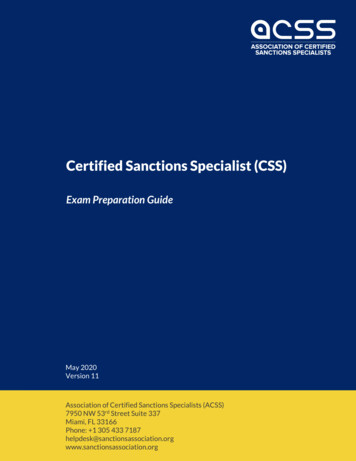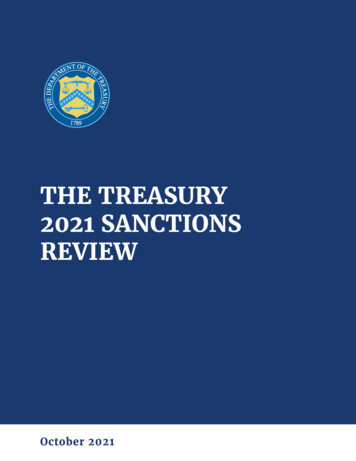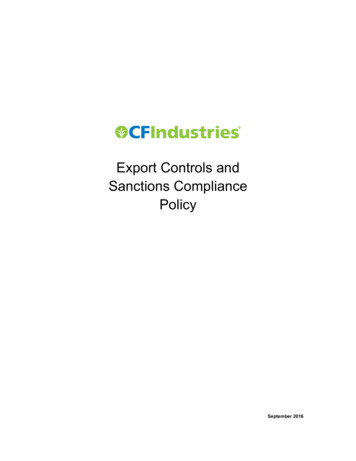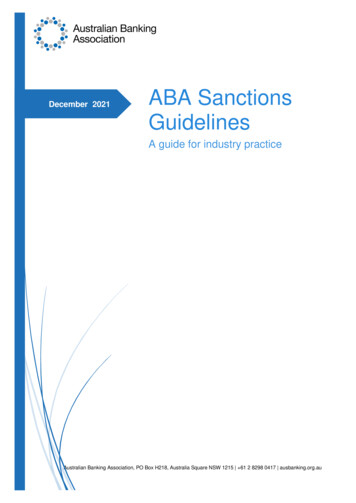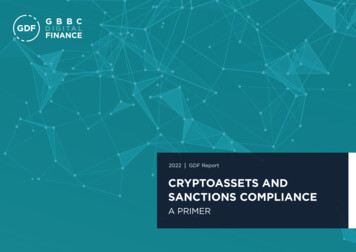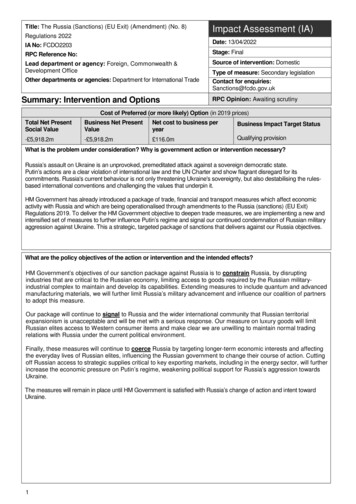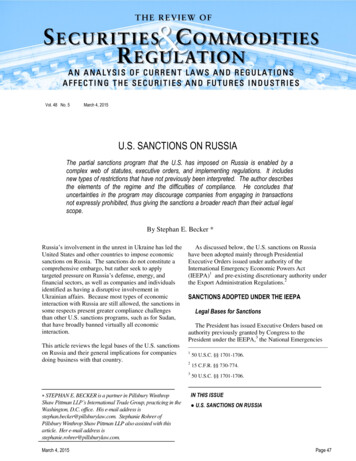
Transcription
Vol. 48 No. 5March 4, 2015U.S. SANCTIONS ON RUSSIAThe partial sanctions program that the U.S. has imposed on Russia is enabled by acomplex web of statutes, executive orders, and implementing regulations. It includesnew types of restrictions that have not previously been interpreted. The author describesthe elements of the regime and the difficulties of compliance. He concludes thatuncertainties in the program may discourage companies from engaging in transactionsnot expressly prohibited, thus giving the sanctions a broader reach than their actual legalscope.By Stephan E. Becker *Russia’s involvement in the unrest in Ukraine has led theUnited States and other countries to impose economicsanctions on Russia. The sanctions do not constitute acomprehensive embargo, but rather seek to applytargeted pressure on Russia’s defense, energy, andfinancial sectors, as well as companies and individualsidentified as having a disruptive involvement inUkrainian affairs. Because most types of economicinteraction with Russia are still allowed, the sanctions insome respects present greater compliance challengesthan other U.S. sanctions programs, such as for Sudan,that have broadly banned virtually all economicinteraction.As discussed below, the U.S. sanctions on Russiahave been adopted mainly through PresidentialExecutive Orders issued under authority of theInternational Emergency Economic Powers Act(IEEPA)1 and pre-existing discretionary authority underthe Export Administration Regulations.2This article reviews the legal bases of the U.S. sanctionson Russia and their general implications for companiesdoing business with that —————— STEPHAN E. BECKER is a partner in Pillsbury WinthropShaw Pittman LLP’s International Trade Group, practicing in theWashington, D.C. office. His e-mail address isstephan.becker@pillsburylaw.com. Stephanie Rohrer ofPillsbury Winthrop Shaw Pittman LLP also assisted with thisarticle. Her e-mail address isstephanie.rohrer@pillsburylaw.com.March 4, 2015SANCTIONS ADOPTED UNDER THE IEEPALegal Bases for SanctionsThe President has issued Executive Orders based onauthority previously granted by Congress to thePresident under the IEEPA,3 the National Emergencies150 U.S.C. §§ 1701-1706.215 C.F.R. §§ 730-774.350 U.S.C. §§ 1701-1706.IN THIS ISSUE U.S. SANCTIONS ON RUSSIAPage 47
RSCR Publications LLCPublished 22 times a year by RSCR Publications LLC. Executive and Editorial Offices, 2628 Broadway, Suite29A, New York, NY 10025-5055. Subscription rates: 1,197 per year in U.S., Canada, and Mexico; 1,262 elsewhere (air mail delivered). A 15%discount is available for qualified academic libraries and full-time teachers. For subscription information and customer service call (866) 425-1171or visit our Web site at www.rscrpubs.com. General Editor: Michael O. Finkelstein; tel. 212-876-1715; e-mail mofinkelstein@gmail.com.Associate Editor: Sarah Strauss Himmelfarb; tel. 301-294-6233; e-mail shimmelfarb@comcast.net. To submit a manuscript for publication contactMs. Himmelfarb. Copyright 2015 by RSCR Publications LLC. ISSN: 0884-2426. Reproduction in whole or in part prohibited except bypermission. All rights reserved. Information has been obtained by The Review of Securities & Commodities Regulation from sources believed to bereliable. However, because of the possibility of human or mechanical error by our sources, The Review of Securities & Commodities Regulationdoes not guarantee the accuracy, adequacy, or completeness of any information and is not responsible for any errors or omissions, or for the resultsobtained from the use of such information.Act,4 and the Immigration and Nationality Act of 1952,5among others.The primary statute on which the President relieswhen imposing economic sanctions is the IEEPA.The IEEPA authorizes the President, after declaring anational emergency, to impose a broad range ofrestrictions on trade and commerce between personssubject to U.S. jurisdiction and the country that is thesubject of the embargo. Specifically, IEEPA grantsthe President authority “to deal with any unusual andextraordinary threat, which has its source in whole orsubstantial part outside the United States, to the nationalsecurity, foreign policy, or economy of the UnitedStates .”6For example, there are relatively comprehensiveembargoes imposed on the nations of Iran,7 Sudan,8Syria,9 and North Korea.10 (The U.S. embargo of Cubapre-dated the IEEPA and is maintained under theauthority of other statutes.11) In addition, sanctions �————450 U.S.C. §§ 1601-1651.5Immigration and Nationality Act of 1952, Pub. L. No. 82–414,66 Stat. 163.650 USC § 1701(a).7Executive Orders 12959 (May 7, 1995), 13059 (Aug. 20, 1997),13553 (Sept. 29, 2010), 13628 (Oct. 9, 2012), and 13645 (Jul. 1,2013).8Executive Orders 13069 (Nov. 4, 1997), 13400 (Apr. 27, 2006),and 13412 (Oct. 13, 2006).9imposed on certain entities and individuals associatedwith those (and other) countries, as well as on entitiesand individuals sanctioned for reasons related tonarcotics trafficking, counter-terrorism, nonproliferation, and other foreign policy concerns.The President’s Executive Orders usually areamplified and implemented in more detail throughregulations issued by the Treasury Department’s Officeof Foreign Assets Control (OFAC). Each embargo isimplemented through an independent set of regulations.The scope of most embargoes generally is similar, butthey are not all identical.When entities and individuals are sanctioned, theirnames are published by OFAC on the “List of SpeciallyDesignated Nationals” (SDN List). Among other things,the sanctions require persons subject to U.S. jurisdictionto “block” (freeze) the assets of SDNs and prohibitfinancial transactions with SDNs, either directly orindirectly, regardless of whether the transaction involvesU.S.-origin products or technology. The restrictionsapply to U.S. citizens and companies, and branches andsubsidiaries of foreign companies within the UnitedStates. (In the case of the embargoes of Cuba and Iran,the restrictions apply also to foreign subsidiaries of U.S.companies).12Some Russian entities and individuals were alreadysanctioned under pre-existing sanctions programs beforefootnote continued from previous column announced plans to re-establish diplomatic relations betweenthe United States and Cuba. See ba. Although the United States stillprohibits most trade and transactions with Cuba, the Presidenteased licensing requirements in certain areas, particularlyinvolving telecommunications and internet services, travel,remittances, and treatment of Cuban nationals in thirdcountries.Executive Orders 13338 (May 12, 2004), 13399 (Apr. 26, 2006),13460 (Feb. 15, 2008), 13572 (Apr. 29, 2011), 13573 (May 18,2011), 13582 (Aug. 18, 2011), 13606 (Apr. 23, 2012), and13608 (May 1, 2012).10Executive Orders 13466 (Jun. 26, 2008), 13551 (Aug. 30,2010), 13570 (Apr. 18, 2011).11The United States maintains a comprehensive economicembargo of Cuba under an older statute, the Trading with theEnemy Act, 50 U.S.C. App. §§ 5, 16, as well as the CubanDemocracy Act of 1992, 22 U.S.C. §§ 6001-6010, and theCuban Liberty and Democratic Solidarity (Libertad) Act of1996, 22 U.S.C. §§ 6021- 6091. President Obama recentlyMarch 4, 20151231 C.F.R. § 515.329 and§ 560.215. Some of the embargoes, inparticular the embargoes of Iran and Sudan, impose obligationson non-U.S. persons not to re-export U.S. origin goods andtechnology to embargoed countries. See, e.g., 31 C.F.R.§538.205.Page 48
the United States took its first actions relating to Ukrainein March 2014. This article focuses on the sanctions thathave been adopted specifically in relation to the unrest inUkraine.The main aspects of the sanctions have been imposedunder a series of Presidential Executive Orders: Executive Order 13660 (March 6, 2014), blocks allproperty and interests in property that are in theUnited States, or within the possession or control ofU.S. persons that belong to persons determined bythe U.S. Government to be involved in the unrest inUkraine, or to have misappropriated Ukrainian stateassets. The order also provides authority to denyvisas to such persons to prohibit their entry into theUnited States. Executive Order 13661 (March 17, 2014) providesauthority to block the assets of and deny visas toadditional categories of persons, including Russiangovernment officials and entities operating in thearms and related materiel sector in Russia. Thisorder also specifically named seven Russiangovernment officials to be sanctioned. Executive Order 13662 (March 20, 2014) created aframework for a new type of sanctions, known as“sectoral sanctions,” that could be imposed onsectors of the Russian economy, including financialservices, energy, metals and mining, engineering,and defense and related materiel.OFAC has taken further actions to implement theseorders, which fall generally into two categories. First,OFAC has designated a number of individuals andentities to be placed on the SDN List pursuant toExecutive Orders 13660 and 13661; assets of thoseindividuals and entities that are within U.S. jurisdictionare blocked, and persons subject to U.S. jurisdictioncannot do business with them. As of December 2014, 93individuals and entities are designated under theseorders. The individuals include Russian governmentofficials, prominent Russian business persons with tiesto the government, and separatist leaders. Thedesignations also have included entities that have beennationalized in Crimea, are owned or controlled by adesignated party, are related to or provide support to theRussian government, are separatist groups in Ukraine, orare entities in the arms and related materiel sector.Second, OFAC has implemented the sectoralsanctions. The first step was the issuance of twoMarch 4, 2015“directives” on July 16, 2014.13 Directive 1 announcedthat the financial services sector of Russia is covered bythe sectoral sanctions and designated certain Russianbanks.14 The sectoral sanctions, however, were not asbroad as those for other persons on the SDN List. Thesanctions were limited to transacting in, providingfinancing for, or otherwise dealing in new debt of longerthan 90 days maturity, or new equity for these persons,their property, or their interests in property.15 All othertransactions remain unrestricted. On September 12,2014, this directive was amended so that debt of longerthan 30 days (rather than 90 days) is now covered.16 Asof December 2014, six financial institutions aredesignated under these sanctions.Directive 2, also issued on July 16, announced thatsectoral sanctions would be applied to Russia’s energysector.17 For this sector, sanctions were limited totransacting in, providing financing for, or otherwisedealing in debt of longer than 90 days maturity for thesepersons, their property, or their interests in property.18(No restrictions were placed on transactions involvingnew equity.) A revised version of Directive 2 waspublished on September 12, but the substance was notchanged.19 As of December 2014, four entities aredesignated under these sanctions.Also on September 12, OFAC issued Directives 3and 4. Directive 3 applies the sectoral sanctions toRussia’s defense and related materiel sector.20 For thissector, the restrictions apply to dealings in new debt ————13Directives 1 and 2 (as amended) under Executive Order tions/Programs/Documents/eo13662 directives.pdf.14Id.15Id.16Directive 1 (as amended) under Executive Order tions/Programs/Documents/eo13662 directive1.pdf.17Directive 2 under Executive Order tions/Programs/Documents/eo 13662 directive2.pdf.18Id.19Directive 2 (as amended) under Executive Order tions/Programs/Documents/eo13662 directive2.pdf.20Directive 3 under Executive Order tions/Programs/Documents/eo13662 directive3.pdf.Page 49
longer than 30 days.21 Other dealings are not restricted.As of December 2014, one entity is designated underthese sanctions.Directive 4 prohibits any person subject to U.S.jurisdiction from providing, exporting, or re-exportinggoods, technology, or services (except financial services)in support of exploration or production for deepwater,Arctic offshore, or shale projects that have the potentialto produce oil for Russia, or in Russian waters, inrelation to entities sanctioned under this directive.22 Asof December 2014, five entities are designated underthese sanctions: Gazprom Neft, Gazprom OAO, Lukoil,Rosneft, and Surgutneftegas.Entities sanctioned under the sectoral sanctionsprogram are placed on the Sectoral Sanctions List (“SSIList”), which is distinct from the SDN List.23Interpretation and ApplicationThe sanctions have raised a number of issues ofinterpretation and application. OFAC has issuedguidance in the form of “frequently asked questions”that deal with subjects such as the following.Fifty Percent Rule. In the context of other sanctionsprograms, OFAC had previously issued guidance that ————21Id.22Directive 4 under Executive Order tions/Programs/Documents/eo13662 directive4.pdf.23On December 19, 2014, the President issued an ExecutiveOrder imposing a broad investment and trade embargo onCrimea, including prohibitions on the following: newinvestment in Crimea by U.S. persons wherever located,imports into the United States of goods, services, or technologyfrom Crimea, and exports, re-exports, sales, or supplies ofgoods, services, or technology to Crimea. The Executive Orderalso provides for blocking the property of any person who isdetermined by the Treasury Department to be operating inCrimea, to be a leader of any entity operating in Crimea, to beowned or controlled by or acting on behalf of any personsblocked under the Executive Order, or to have materiallyassisted, financed, or otherwise supported any persons blockedunder the Executive Order. Simultaneously with the issuanceof the Executive Order, OFAC issued General License No. 4,authorizing the exportation or re-exportation of certainagricultural commodities, medicine, medical supplies, andreplacement parts to Crimea. The Commerce Department isexpected to issue rules under the Export AdministrationRegulations to implement the trade restrictions.March 4, 2015entity owned directly or indirectly by an SDN wasconsidered blocked regardless of whether such entityitself was listed as an SDN. On August 13, 2014, OFACissued revised guidance in relation to the Russiasanctions, clarifying that the fifty percent rule applies toentities owned 50 percent or more in the aggregate byone or more SDNs.24 In other words, if blocked personA owns 25 percent of an entity, and blocked person Bowns 25 percent, the entity automatically will be treatedas blocked. On the other hand, if a blocked person (orpersons) does not own 50 percent, but controls theentity, the entity is not automatically blocked; OFACadvises proceeding with caution, however, as an entitycontrolled by an SDN could be designated as an SDN inthe future.25 The aggregation does not apply across theSDN and SSI Lists.26 In other words, the ownershipinterest of an entity on the SSI List would not beaggregated with the ownership interest of an entity onthe SDN List.Definition of “Debt.” OFAC has clarified that “debt”includes bonds, loans, extensions of credit, loanguarantees, letters of credit, drafts, banker’s acceptances,discount notes or bills, and commercial paper.27 Thesectoral sanctions apply to new debt (with a maturity of30 or 90 days, depending on the sector), includingdealing in such debt and providing services in support ofsuch debt.28 The restrictions extend to rollover ofexisting debt, if the rollover results in the creation ofnew debt with the specified maturities.29 OFAC hasissued further guidance on such subjects as dealings indepositary receipts, counter-party credit risk, andrevolving credit facilities. With regard to letters ofcredit, OFAC has explained that U.S. persons mayadvise or confirm a letter of credit issued on behalf of anon-sanctioned entity in which an entity subject to thesectoral sanctions is a beneficiary, because the letter ofcredit does not represent an extension of credit to �————24Revised Guidance on Entities Owned by Persons WhoseProperty and Interests in Property are Blocked, Aug. 13, ions/Documents/licensing guidance.pdf.25Id.26Frequently Asked Question No. 373, Sep. 12, y Asked Question No. 371, Sep. 12, age 50
sanctioned entity.30 On the other hand, the restrictionscan apply if a sanctioned entity is the applicant for theletter of credit.31Shale Projects. OFAC also has issued guidance onthe interpretation of the energy sector sanctions. Forexample, OFAC has clarified that the “shale projects”that are covered are those that have the potential toproduce oil from shale formations, and not those projectsthat simply involve drilling through shale to locate orextract oil.32General Licenses. OFAC has issued “generallicenses” that permit certain transactions that wouldotherwise be prohibited under the sectoral sanctions, ifthe conditions of the general license are met. Forexample, General License 1A authorizes transactionsrelated to derivatives that would ordinarily be prohibitedby Directives 1, 2, and 3.33 Similarly, General License 3permits transactions with DenizBank A.S. that Directive1 would ordinarily prohibit.34SANCTIONS UNDER EXPORT ADMINISTRATIONREGULATIONSThe Export Administration Regulations (“EAR”)authorize the U.S. Department of Commerce, actingthrough its Bureau of Industry and Security (“BIS”), toregulate exports and re-exports of nearly all commercialproducts and technologies, including items considered“dual-use” because they have both commercial andmilitary �————————30Frequently Asked Question No. 395, Sep. 12, uently Asked Question No. 418, Nov. 18, Sanctions/Pages/answers2.aspx#sectoral.33General License 1A Authorizing Certain Transactions Relatedto Derivatives Prohibited by Directives 1, 2, and 3 underExecutive Order 13662, Sep. 12, ions/Programs/Documents/ukraine gl1a.pdf.34General License No. 3 Authorizing Transactions OtherwiseProhibited by Directive 1 under Executive Order 13662, Oct. 6,2014, Programs/Documents/ukraine gl3.pdf.35The major categories of items not subject to the EAR aredefense articles regulated under the International Traffic inMarch 4, 2015The EAR apply to transactions that take place outsidethe United States, even when no U.S. person is involved.This is because the EAR apply to U.S.-origin items andtechnology, regardless of where they are located.Further, the EAR apply to non-U.S. products thatincorporate more than “de minimis” controlled U.S.content.36The EAR establishes when prior approval, in the formof an export license, is required for an export from theUnited States, or a re-export or retransfer that takes placeoutside the United States.37 The level of control dependson the classification of an item or technology on theCommerce Control List and the final country destinationof the item/technology.38 The classification categories,known as Export Control Classification Numbers(“ECCNs”), are based on the categories in themultilateral Wassenaar Arrangement, while others aremaintained on a unilateral basis by the United States.39In April 2014, BIS initially froze all licenseapplications for exports to Russia, and subsequentlyannounced that it would deny applications involvingproposed exports or re-exports of high technology itemsto Russia or occupied Crimea that contribute to Russia’smilitary capabilities.40footnote continued from previous column Arms Regulations, 22 C.F.R. §§ 120 et seq., and nuclearproducts and technology regulated by the Department ofEnergy and the Nuclear Regulatory Commission.36For countries subject to full-scale embargoes (Cuba, Iran,Sudan, Syria, and North Korea) the de minimis threshold is 10percent; for other countries, including Russia, the threshold is25 percent. 15 CFR § 734.3.3715 C.F.R. §730.38Id.3915 C.F.R. § 738. The Wassenaar Arrangement on ExportControls for Conventional Arms and Dual-Use Goods andTechnologies is a group of 41 countries that seeks to coordinateexport control policies. Among the activities of the group is todevelop common control list categories. Seehttp://www.wassenaar.org/index.html. Decisions on whether torequire or issue licenses are left to the individual participatingstates and therefore participation in the WassenaarArrangement does not affect the discretion of the U.S.government to establish control categories that are not in theWassenaar control lists.40Commerce Department Announces Expansion of ExportRestrictions on Russia, Apr. 28, 2014, m/press-releases/107-about-Page 51
On August 6, 2014, BIS published a new rule onRussia Industry Sector Sanctions.41 The regulationrequires a license to export from the United States toRussia, re-export from a third country to Russia, ortransfer within Russia any item that is subject to theEAR if (i) the item is covered by certain ECCNs or islisted in a new regulatory supplement that identifiesitems by certain “Schedule B” numbers and (ii) the itemwill be used directly or indirectly in exploration for, orproduction of, oil or gas in Russian deepwater, Arcticoffshore, or shale formations in Russia.42 There is apresumption of denial when the item is for use in one ofthese projects that has the potential to produce oil.43Unlike the OFAC sanctions, these EAR sanctions are notlimited to projects involving the Russian companies onthe SSI List; they apply more generally.The following pre-existing ECCNs are included in therestrictions: ECCN 1C992, which covers certain commercialcharges and devices; ECCN 3A229, which covers certain firing sets andequivalent high-current pulse generators; ECCN 3A231, which covers certain neutrongenerator systems; ECCN 3A232, which covers certain detonators andmultipoint initiation systems; ECCN 6A991, which covers certain marine andterrestrial acoustic equipment; and ECCN 8A992, which covers certain vessels, marinesystems, and related equipment and parts.Items covered by these ECCNs previously could beexported to Russia without a license. Two new ECCNswere created specifically for this sanction: ECCN 0A998, which covers oil and gas explorationdata and software, including seismic analysis data,hydraulic fracturing design and analysis softwareand data, and hydraulic fracturing materials.44As discussed above, the new rule included a list ofitems categorized by Schedule B numbers. Schedule Bis a classification system used by the U.S. CensusBureau to collect statistical information on U.S.exports.45 The Schedule B numbering system is basedon the four- and six-digit headings and subheadings ofthe Harmonized System, the multilateral agreement oncustoms tariff classifications.46 The categories listeddescribe items such as certain types of pipes, welltubings and casings, drill bits and tools, oilfield pumps,gas separation equipment, oil drilling and productionplatforms and machinery, and drilling derricks.47In addition to these licensing restrictions for U.S.origin products and technology, BIS has implementedsanctions on specific Russian entities that parallel thoseof OFAC. BIS maintains the Entity List, a list of entitiesthat have engaged in activities deemed contrary to U.S.national security or foreign policy.48 For most entitieson the list, a license is required for any person (includingnon-U.S. persons) to export, re-export, or retransfer anyitems subject to the EAR – even when a license wouldnot otherwise be required to export to the country of theentity.49 Approximately 30 Russian entities have beenplaced on the Entity List to prevent them from acquiringany U.S.-origin articles or technology.50BIS has also added five Russian entities to the listwith more limited restrictions – exports of U.S. originitems to those entities require a license only when theitems are to be used in exploration for, or production of,oil or gas in Russian deepwater, Arctic offshore, or shaleformations in Russia.51 Unlike the other restrictionsdiscussed above, this licensing requirement for —————44Id.45Export.gov, The Harmonized System, http://www.export.gov/logistics/eg main 018119.asp.46Id.footnote continued from previous page 4779 Fed. Reg. 45675 (Aug. 6, restrictionson-russia.4815 C.F.R. § 744 Supplement No. 4.49Id.5079 Fed. Reg. 21394 (Apr. 16, 2014); 79 Fed. Reg. 24558(May 1, 2014); 79 Fed. Reg. 42452 (Jul. 22, 2014); and 79 Fed.Reg. 45675 (Aug. 6, 2014).5179 Fed. Reg. 55608 (Sep. 17, 2014).ECCN 8D999, which covers software speciallydesigned for the operation of unmanned vessels usedin Russia’s oil and gas industry; and4179 Fed. Reg. 45675 (Aug. 6, 2014).42Id.43Id.March 4, 2015Page 52
specific entities applies to all U.S. origin items, if theyare destined for use in such projects.52 There will be apresumption of denial for these license applicationswhen the projects have the potential to produce oil.53BIS also prohibited the export without a license ofcertain items to Russia when the exporter knows that theitem is intended for a “military end use” in Russia,extending a pre-existing restriction that already appliedto China.54 License applications for such items aresubject to review on a case-by-case basis, with a policyof denial if the items would make a material contributionto Russia’s military capabilities. The listed categoriesare also subject to a license requirement if equipment inthose categories is being sold for use in Russia by a“military end user,” regardless of actual use. A “militaryend user” means the national armed services, as well asthe national guard and national police, governmentintelligence or reconnaissance organizations, or anyperson or entity whose actions or functions are intendedto support “military end uses” as defined in theregulations.55 Items not covered by one of thedesignated ECCN categories are not subject to thisrestriction.56PENALTIES FOR VIOLATIONSViolations of regulations implemented under theIEEPA can be punished with criminal and civilpenalties. The criminal penalties can include fines up to 1 million, and up to 20 years imprisonment forindividuals.57 The civil penalties include fines of up to 250,000 per violation or an amount twice the value ofthe transaction that is the basis of the violation.58OFAC’s regulations provide guidance for civil ��—————52Id.53Id.54The list of ECCNs covered by this rule is contained in 15C.F.R. Part 744, Supp. No. 2.5515 C.F.R. § 744.21.56Other U.S. agencies have also adopted more restrictivelicensing policies for Russia, including the State Department’sDirectorate of Defense Trade Controls with respect to licensesunder the International Traffic in Arms Regulations. U.S. armstrade with Russia has not been significant, however, so theimpact of those policies has not been as significant as that ofother sanctions.5750 U.S.C. §§ 1705.58Id.March 4, 2015calculations and factors which ma1y aggravate(increase) or mitigate (decrease) penalties.59Penalties for violations of the EAR are also based onthe provisions of the IEEPA and therefore the samepenalty structure applies. In addition, BIS is authorizedto penalize violations by issuing an order denying anindividual or company the “privilege” of engaging inexport transactions (known as a “denial order”).60 Thenames of persons who are subject to denial orders arepublished on the Denied Persons List, and engaging inan export transaction involving U.S. origin goods with aperson on the List is itself a violation of theregulations.61 For foreign persons, a denial order has theeffect of prohibiting the purchase or sale of any U.S.origin goods or technology, regardless of whether thosegoods or technology are otherwise controlled.NEW LEGISLATIONReflecting intense congressional interest in U.S.relations with Russia, the Congress enacted the UkraineFreedom Support Act of 2014, which the Presidentsigned into law on December 18, 2014. The statuterequires sanctions to be imposed against Russian armsbroker/exporter Rosoboronexport and governmentowned companies that the President determines produce,transfer, or broker sales of defense articles to Syria,Ukraine, Georgia, or Moldova. The statute also providesauthority for the President to impose sanctions againstforeign persons who make investments in “specialRussian crude oil projects,” against foreign financialinstitutions that facilitate sanctioned activities, andagainst Gazprom if it is determined that Gazprom iswithholding gas supplies to NATO countries, Ukraine,Georgia, or Moldova. Upon signing the law, thePresident stated that “the Administration does not intendto impose sanctions under this law, but the Act gives theAdministration additional authorities that could beutilized, if circumstances warranted.”62 It remainsunclear whether the Congress will take further action toattempt to pressure the President to tighten sanctions �——————5931 C.F.R. Part 501, App.
Shaw Pittman LLP's International Trade Group, practicing in the Washington, D.C. office. His e-mail address is . doing business with that country. As discussed below, the U.S. sanctions on Russia . New York, NY 10025-5055. Subscription rates: 1,197 per year in U.S., Canada, and Mexico; 1,262 elsewhere (air mail delivered). A 15%
